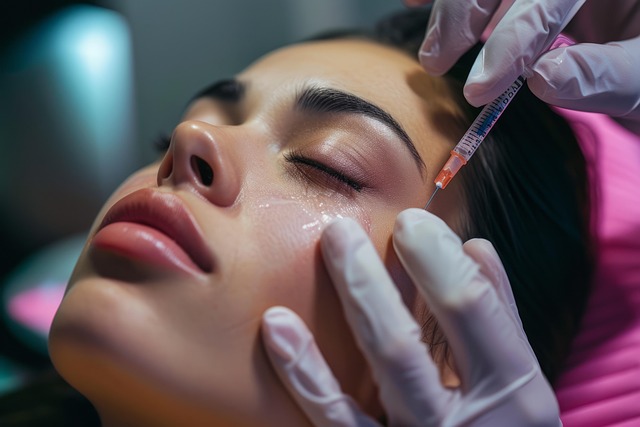Botox and dermal fillers are popular cosmetic treatments with distinct functions. Botox, a neurotoxin derived from bacteria, temporarily paralyzes muscles to smooth fine lines and wrinkles formed by facial expressions. Dermal fillers, on the other hand, add volume by injecting hyaluronic acid-based substances into the skin. While dermal fillers offer longer-lasting results, Botox is more effective for dynamic wrinkles. The choice between these treatments depends on individual goals, budget, and specific areas of concern. For professionals, Botox's preventative properties, offering a subtle yet effective boost in confidence, make it an ideal choice for maintaining a youthful appearance without the need for permanent changes.
“Unwind the secrets of professional preventative Botox care, a game-changer in the realm of aesthetics. As busy professionals juggle demanding careers, understanding Botox’s unique benefits becomes crucial. This article delves into the nuances of Botox and dermal fillers, highlighting their distinct roles. We explore the science behind its muscle-relaxing effects, targeting specific areas for professional use, and safety considerations.
Learn how to choose the right provider, integrate Botox into your skincare routine, and maintain optimal results, ensuring you look and feel your best in today’s fast-paced world.”
Understanding Botox and Dermal Fillers: Unveiling the Differences

Botox and dermal fillers are both popular cosmetic treatments, but they serve distinct purposes in addressing skin concerns. Understanding their differences is crucial for individuals considering non-invasive aesthetic procedures. Botox, a neurotoxin derived from bacteria, temporarily paralyzes muscles, smoothing out fine lines and wrinkles. It’s particularly effective for treating dynamic wrinkles formed by facial expressions, such as frown lines between the eyebrows or crow’s feet at the eyes.
In contrast, dermal fillers are hyaluronic acid-based substances injected into the skin to add volume and enhance certain features. They plump up deep wrinkles, improve skin texture, and can even reshape facial contours. Dermal fillers offer longer-lasting results than Botox but are generally used for more pronounced age-related changes in the skin. Both treatments have their merits, and the choice between Botox vs dermal fillers depends on individual goals, budget, and the specific areas of concern.
Benefits of Preventative Botox Treatments for Professionals

Preventative Botox treatments offer a range of benefits for professionals looking to maintain and enhance their appearance, especially as they age. One of the key advantages is its ability to smooth out fine lines and wrinkles, providing a more youthful and rested look. This can be particularly beneficial for individuals in high-pressure professions where first impressions matter; a subtle yet effective boost in confidence can significantly impact performance and client interactions.
Compared to dermal fillers, Botox presents a unique approach to skincare. While fillers add volume and plumpness to the skin, Botox works by relaxing muscles, preventing dynamic wrinkles from forming. This makes it an ideal choice for professionals who want long-lasting results without the need for frequent top-ups, as is often required with fillers. Moreover, Botox has a proven track record in reducing crow’s feet, forehead wrinkles, and frown lines, ensuring a more polished and professional appearance.
The Science Behind Botox: How It Works on Muscle Movement

Botox, a popular cosmetic treatment, has revolutionized the way we approach anti-aging and aesthetic enhancements. But what exactly is the science behind its effectiveness? At its core, Botox is a neurotoxin produced by a bacterium called Clostridium botulinum. When injected into specific muscles, it blocks nerve signals that stimulate muscle contraction. This results in a temporary paralysis of the targeted muscles, which is key to its anti-aging benefits. By preventing muscle movement, wrinkles are minimized, giving the skin a smoother appearance.
Unlike dermal fillers that add volume and plump the skin, Botox works by reducing dynamic wrinkling caused by repeated muscle contractions. This makes it particularly effective for treating fine lines and crow’s feet around the eyes and mouth. The treatment is highly precise, allowing professionals to target specific areas, ensuring a natural-looking result. Moreover, its temporary nature means results can be adjusted or stopped at any time, making it a flexible option in the world of cosmetic treatments, contrasting with dermal fillers that offer more permanent solutions.
Targeting Specific Areas: Identifying Potential for Professional Use

In the realm of professional skincare, targeted injections offer a precise approach to anti-aging treatments, with Botox leading the way as a popular choice among experts. Unlike dermal fillers that plump and enhance, Botox focuses on relaxing muscle activity, making it ideal for specific areas such as frown lines, crow’s feet, and neck bands. This specificity is crucial when considering professional preventative care, allowing practitioners to target problem zones without over-plumping or causing undesirable side effects.
Professionals in the field often recommend Botox for individuals seeking a subtle yet effective way to minimize wrinkles and prevent their progression. By addressing key areas early on, patients can maintain a youthful appearance, making it an attractive option as an alternative to more invasive procedures or extensive filler treatments. This strategic approach ensures that both the effectiveness of Botox and its potential for preventative care are fully utilized.
Safety Considerations: Ensuring Quality Care for Busy Professionals

For busy professionals, considering preventative care is a crucial step in maintaining a youthful appearance and managing the signs of aging. When it comes to aesthetic treatments like Botox or dermal fillers, safety should be the top priority. It’s essential to choose qualified, experienced practitioners who use sterile, high-quality products. This reduces the risk of adverse reactions and ensures a comfortable, effective experience.
While both Botox and dermal fillers offer anti-aging benefits, they work in different ways. Botox primarily prevents muscle contractions that cause wrinkles, providing a smoother appearance. Dermal fillers, on the other hand, add volume and plumpness to the skin by injecting a substance beneath the surface. Understanding these differences allows professionals to make informed decisions about which treatment aligns best with their goals and lifestyle.
Choosing the Right Provider: What to Look for in a Botox Specialist

When considering preventative Botox care, choosing the right provider is paramount. Seek out a specialist with extensive experience and a proven track record in cosmetic injections. Look for practitioners who are board-certified or have advanced training in dermatology or plastic surgery to ensure they possess the expertise needed to administer Botox correctly. This expertise is crucial, as it guarantees safe and effective treatments, minimising risks and maximising results.
In your search, compare providers’ qualifications, facility sterility, and patient testimonials. Remember, while Botox offers remarkable anti-aging benefits, it’s not a one-size-fits-all solution—a specialist should tailor the treatment to your specific needs. This is where experience shines; a skilled provider can differentiate between fine lines, wrinkles, and dynamic expression lines, ensuring you receive the most suitable and long-lasting results, leaving you feeling confident and rejuvenated, with a natural appearance that enhances your overall look, rather than altering it through excessive use of injectables, unlike some of its popular alternative like dermal fillers.
Integrating Botox into Your Skincare Routine: Tips for Consistency

Integrating Botox into your skincare routine can be a game-changer for achieving and maintaining youthful-looking skin, but consistency is key to reaping the full benefits. Unlike dermal fillers, which provide instant results, Botox works gradually by preventing muscle contractions that cause dynamic wrinkles. To ensure optimal results, consider making Botox part of your daily or weekly self-care regimen.
For maximum efficiency, maintain a regular treatment schedule recommended by your dermatologist. Additionally, incorporate non-invasive practices like hydration, sun protection, and gentle cleansing to enhance the effects of Botox. Remember, combining professional treatments with at-home care provides a holistic approach to skincare, resulting in more significant and lasting improvements compared to solely relying on Botox or dermal fillers.
Long-term Effects and Maintenance: Optimizing Results for Career-driven Individuals

For career-driven individuals, maintaining a professional and youthful appearance is often a priority. While initial Botox treatments can provide significant results in reducing fine lines and wrinkles, understanding the long-term effects is crucial. Unlike dermal fillers that may require more frequent top-ups, Botox offers a more sustainable approach to anti-aging. Its effects typically last between 3 to 6 months, providing a lengthy period of smoothness and enhanced skin quality.
To optimize these results, a tailored maintenance plan is essential. This involves regular consultations with a certified dermatologist or aesthetic specialist who can assess the individual’s skin and provide customized advice. By combining strategic treatments with healthy lifestyle choices such as hydration, sun protection, and proper nutrition, one can maximize the benefits of Botox, ensuring a youthful appearance that complements their professional goals. Additionally, staying informed about the latest advancements in cosmetic procedures, including alternatives like dermal fillers, allows for well-informed decisions to maintain optimal results over time.
